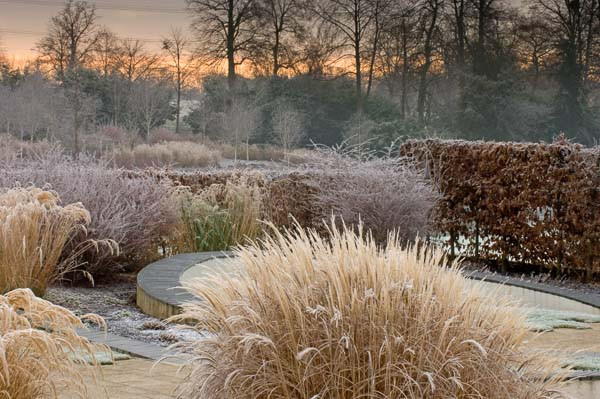Designing with Ornamental Grasses
Adding drama and powerful structure to the landscape, Miscanthus sinensis (Chinese Silver Grass) are fabulous ornamental grasses that should have a spot in any garden. Very gifted, these grasses are easy to grow, wonderful in winter, add elegance and movement to the landscape, are generally pest and disease free, and require little maintenance. Traditionally used in Japan in decorative art and gardens, Miscanthus made a royal entrance into the occidental gardens about a century ago, thanks to their spectacular feathery plumes towering above their graceful arching foliage and year-long interest in the garden.

| Hardiness |
5 - 9 |
|---|---|
| Plant Type | Ornamental Grasses |
| Genus | Miscanthus |
| Exposure | Full Sun, Partial Sun |
| Season of Interest |
Summer (Mid, Late) Fall Winter |
| Maintenance | Low |
| Water Needs | Average |
| Soil Type | Chalk, Clay, Loam, Sand |
| Soil pH | Acid, Alkaline, Neutral |
| Soil Drainage | Moist but Well-Drained, Well-Drained |
| Characteristics | Dried Arrangements, Cut Flowers, Showy |
| Tolerance | Drought, Deer, Salt, Rabbit |
| Attracts | Birds |
| Landscaping Ideas | Hedges And Screens, Beds And Borders |
| Garden Styles | City and Courtyard, Coastal Garden, Informal and Cottage, Modern Garden, Prairie and Meadow, Traditional Garden |
Pictures are courtesy of Botanik Foto and Gap Photos/ Richard Bloom, Christa Brand, Elke Borkowski
| Hardiness |
5 - 9 |
|---|---|
| Plant Type | Ornamental Grasses |
| Genus | Miscanthus |
| Exposure | Full Sun, Partial Sun |
| Season of Interest |
Summer (Mid, Late) Fall Winter |
| Maintenance | Low |
| Water Needs | Average |
| Soil Type | Chalk, Clay, Loam, Sand |
| Soil pH | Acid, Alkaline, Neutral |
| Soil Drainage | Moist but Well-Drained, Well-Drained |
| Characteristics | Dried Arrangements, Cut Flowers, Showy |
| Tolerance | Drought, Deer, Salt, Rabbit |
| Attracts | Birds |
| Landscaping Ideas | Hedges And Screens, Beds And Borders |
| Garden Styles | City and Courtyard, Coastal Garden, Informal and Cottage, Modern Garden, Prairie and Meadow, Traditional Garden |
Create a membership account to save your garden designs and to view them on any device.
Becoming a contributing member of Gardenia is easy and can be done in just a few minutes. If you provide us with your name, email address and the payment of a modest $25 annual membership fee, you will become a full member, enabling you to design and save up to 25 of your garden design ideas.
Join now and start creating your dream garden!
Create a membership account to save your garden designs and to view them on any device.
Becoming a contributing member of Gardenia is easy and can be done in just a few minutes. If you provide us with your name, email address and the payment of a modest $25 annual membership fee, you will become a full member, enabling you to design and save up to 25 of your garden design ideas.
Join now and start creating your dream garden!